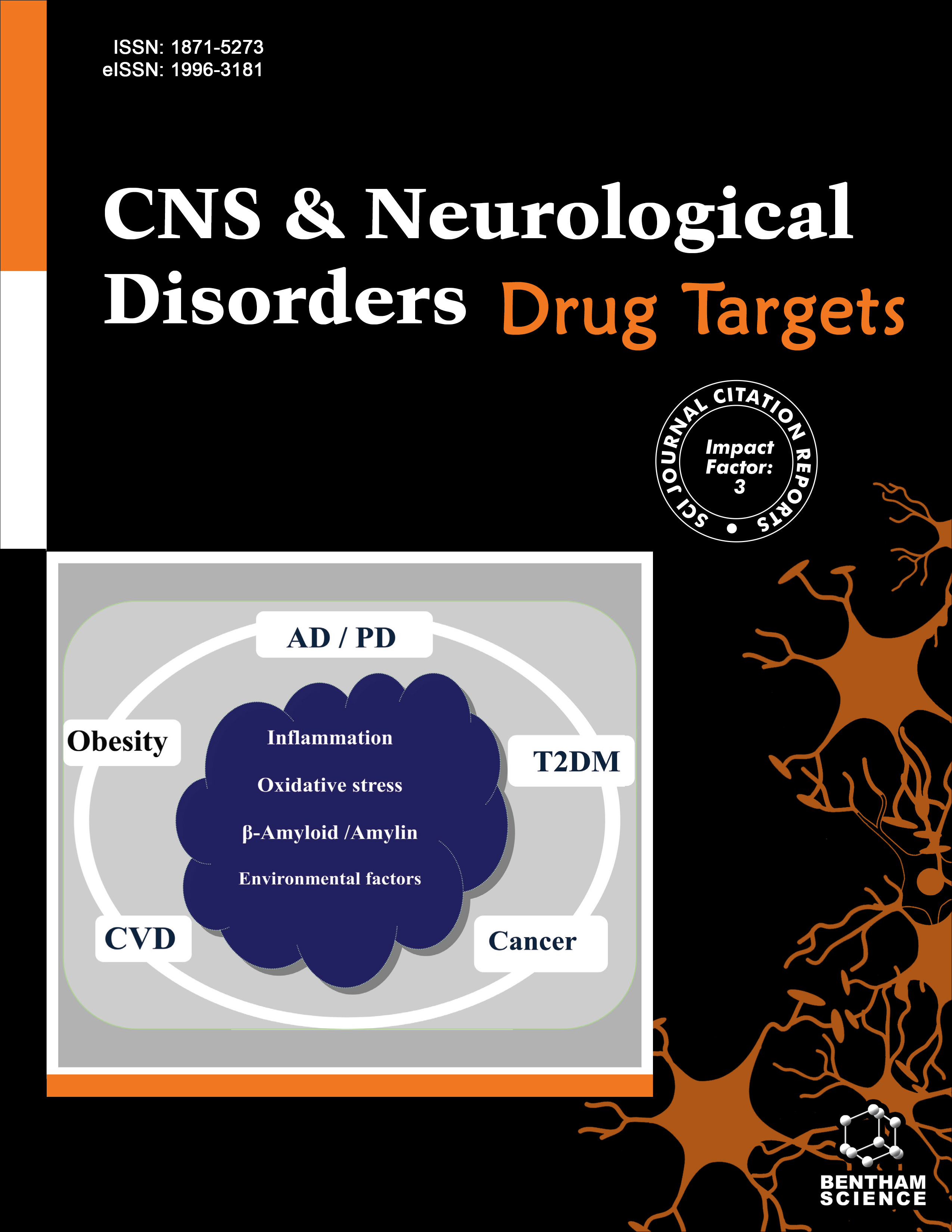- Home
- A-Z Publications
- CNS & Neurological Disorders - Drug Targets (Formerly Current Drug Targets - CNS & Neurological Disorders)
- Previous Issues
- Volume 21, Issue 8, 2022
CNS & Neurological Disorders - Drug Targets (Formerly Current Drug Targets - CNS & Neurological Disorders) - Volume 21, Issue 8, 2022
Volume 21, Issue 8, 2022
-
-
Are Lysosomes Potential Therapeutic Targets for Parkinson’s Disease?
More LessAuthors: Alessandro Petese, Valentina Cesaroni, Silvia Cerri and Fabio BlandiniParkinson´s Disease (PD) is the second most common neurodegenerative disorder, affecting ∼2-3% of the population over 65 years old. In addition to progressive degeneration of nigrostriatal neurons, the histopathological feature of PD is the accumulation of misfolded α-synuclein protein in abnormal cytoplasmatic inclusions, known as Lewy Bodies (LBs). Recently, Genome-Wide Association Studies (GWAS) have indicated a cl Read More
-
-
-
Regulation of Microtubule: Current Concepts and Relevance to Neurodegenerative Diseases
More LessAuthors: Anirban Ghosh and Shamsher SinghNeurodevelopmental Disorders (NDDs) are abnormalities linked to neuronal structure and irregularities associated with the proliferation of cells, transportation, and differentiation. NDD also involves synaptic circuitry and neural network alterations known as synaptopathy. Microtubules (MTs) and MTs-associated proteins help to maintain neuronal health as well as their development. The microtubular dynamic structure plays a Read More
-
-
-
Lactose and Casein Cause Changes on Biomarkers of Oxidative Damage and Dysbiosis in an Experimental Model of Multiple Sclerosis
More LessBackground and Objectives: Experimental Autoimmune Encephalomyelitis (EAE) in rats closely reproduces Multiple Sclerosis (MS), a disease characterized by neuroinflammation and oxidative stress that also appears to extend to other organs and their compartments. The origin of MS is a matter for discussion, but it would seem that altering certain bacterial populations present in the gut may lead to a proinflammatory con Read More
-
-
-
Dipsacoside B Exerts a Beneficial Effect on Brain Injury in the Ischemic Stroke Rat through Inhibition of Mitochondrial E3 Ubiquitin Ligase 1
More LessAuthors: Kai-Di Ren, Zi-Mei Peng, Jing Tian, Ya-Wei Peng, Yi-Yue Zhang, Xiao-Jie Zhang, Zhong-Yang Hu, Xiu-Ju Luo and Jun PengBackground: Upregulation of mitochondrial E3 ubiquitin ligase 1 (Mul1) contributes to brain injury in ischemic stroke due to disturbance of mitochondrial dynamics, and bioinformatics analysis predicts that Mul1 is a potential target of Dipsacoside B. Objective: The aim of the study was to explore whether Dipsacoside B can exert a beneficial effect on brain injury in the ischemic stroke rat via targeting Mul1. Methods: The S Read More
-
-
-
The Development of a PBPK Model for Atomoxetine Using Levels in Plasma, Saliva and Brain Extracellular Fluid in Patients with Normal and Deteriorated Kidney Function
More LessAuthors: Mo'tasem M. Alsmadi, Laith N. AL Eitan, Nasir M. Idkaidek and Karem H. AlzoubiBackground: Atomoxetine is a treatment for attention-deficit hyperactivity disorder. It inhibits Norepinephrine Transporters (NET) in the brain. Renal impairment can reduce hepatic CYP2D6 activity and atomoxetine elimination which may increase its body exposure. Atomoxetine can be secreted in saliva. Objective: The objective of this work was to test the hypothesis that atomoxetine saliva levels (sATX) can be used to predict AT Read More
-
-
-
Coenzyme Q10 in the Treatment of Attention Deficit Hyperactivity Disorder in Children: A Randomized Controlled Trial
More LessAuthors: Fatma Gamal, Osama El Agami and Abeer SalamahBackground: Attention Deficit Hyperactivity Disorder is a common child neurobehavioral disorder whose pathogenesis is not completely understood. However, some evidence indicates a crucial link between this disorder and the degree of oxidative stress. Coenzyme Q10 (ubiquinol) is an antioxidant that may play a significant role in the treatment of Attention Deficit Hyperactivity Disorder. Objective: To assess the safety an Read More
-
-
-
Comparing the Efficacy and Safety of Dexmedetomidine/Ketamine with Propofol/Fentanyl for Sedation in Colonoscopy Patients: A Doubleblinded Randomized Clinical Trial
More LessBackground: In this double-blinded randomized clinical trial, we aimed to compare the safety and efficacy of a combination of Dexmedetomidine and Ketamine (DK) with Propofol and Fentanyl (PF) for sedation in colonoscopy patients. Methods: In this study, 64 patients who underwent colonoscopy were randomized into two groups: 1) A, which received PF, and 2) B, which received DK for sedation. Among 64 patients, 3 Read More
-
Volumes & issues
-
Volume 24 (2025)
-
Volume 23 (2024)
-
Volume 22 (2023)
-
Volume 21 (2022)
-
Volume 20 (2021)
-
Volume 19 (2020)
-
Volume 18 (2019)
-
Volume 17 (2018)
-
Volume 16 (2017)
-
Volume 15 (2016)
-
Volume 14 (2015)
-
Volume 13 (2014)
-
Volume 12 (2013)
-
Volume 11 (2012)
-
Volume 10 (2011)
-
Volume 9 (2010)
-
Volume 8 (2009)
-
Volume 7 (2008)
-
Volume 6 (2007)
-
Volume 5 (2006)
Most Read This Month
Article
content/journals/cnsnddt
Journal
10
5
false
en

Most Cited Most Cited RSS feed
-
-
A Retrospective, Multi-Center Cohort Study Evaluating the Severity- Related Effects of Cerebrolysin Treatment on Clinical Outcomes in Traumatic Brain Injury
Authors: Dafin F. Muresanu, Alexandru V. Ciurea, Radu M. Gorgan, Eva Gheorghita, Stefan I. Florian, Horatiu Stan, Alin Blaga, Nicolai Ianovici, Stefan M. Iencean, Dana Turliuc, Horia B. Davidescu, Cornel Mihalache, Felix M. Brehar, Anca . S. Mihaescu, Dinu C. Mardare, Aurelian Anghelescu, Carmen Chiparus, Magdalena Lapadat, Viorel Pruna, Dumitru Mohan, Constantin Costea, Daniel Costea, Claudiu Palade, Narcisa Bucur, Jesus Figueroa and Anton Alvarez
-
-
-
- More Less

